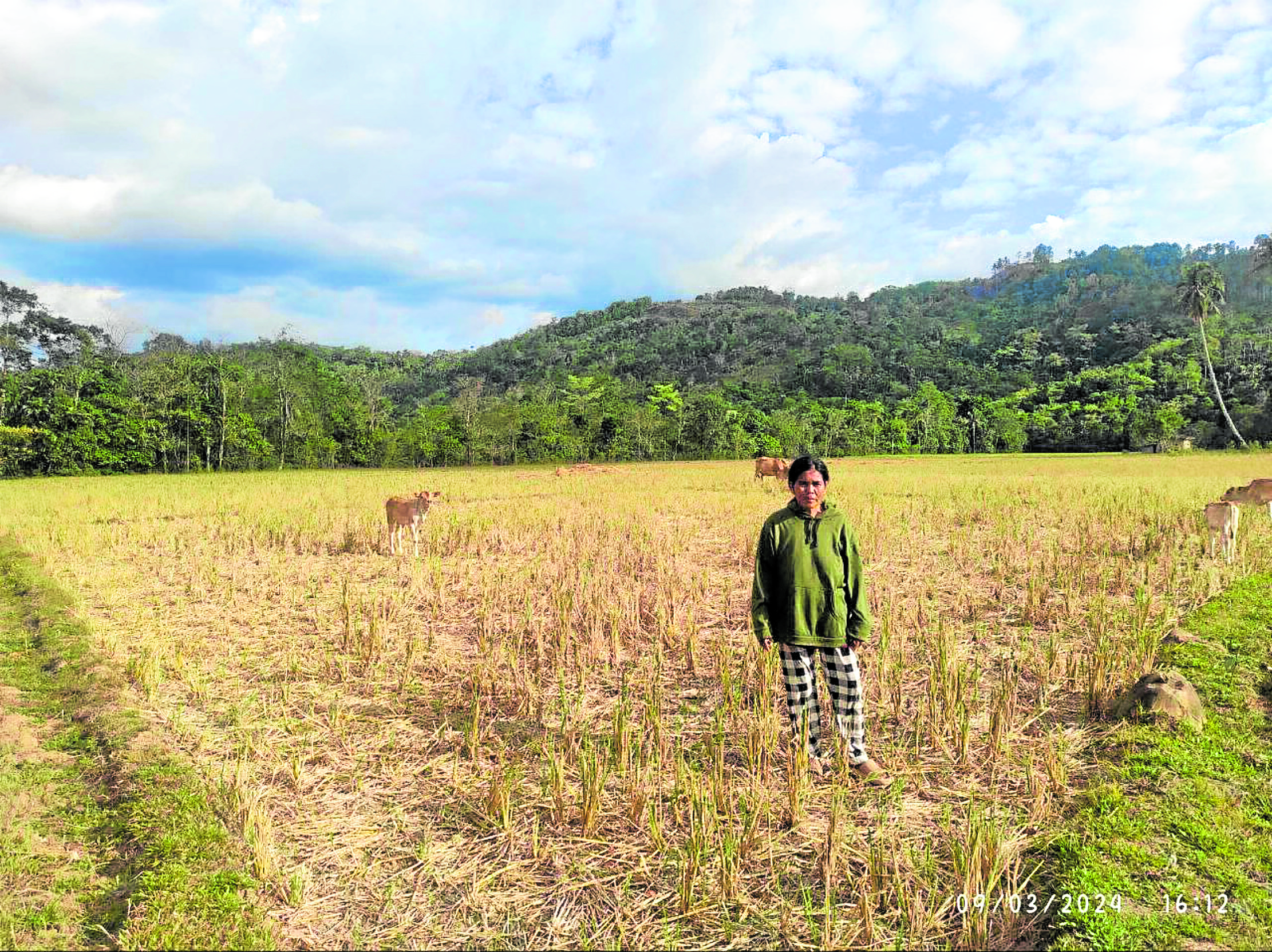DA: Agriculture losses due to El Niño impact now P3.9 billion

ALL DRY A farmer in Pagadian City in Zamboanga del Sur province visits her rice farm, nowall dried up due to the absence of rain amid the El Niño weather phenomenon. The Zamboanga Peninsula is among the 11 regions in the country worst hit by the dry spell and drought. —PHOTO COURTESY OF PAGADIAN CITY AGRICULTURE OFFICE
As the prolonged dry spell and drought brought about by the El Niño weather phenomenon continues to ravage farms across the country, the Department of Agriculture (DA) on Friday said crop and livestock losses have hit P3.94 billion, up by 50 percent from P2.63 billion that the agency reported earlier.
In its latest bulletin, the DA said the impact of El Niño disrupted the livelihood of 73,713 farmers and fisherfolk as of April 16.
READ: El Niño, La Niña together? What to know
Among the worst-hit regions are the Cordillera, Ilocos, Cagayan Valley, Central Luzon, Calabarzon (Cavite, Laguna, Batangas, Rizal, Quezon) Mimaropa (Mindoro, Marinduque, Romblon, Palawan), Bicol, Western Visayas, Zamboanga Peninsula, Davao Region and Soccsksargen (South Cotabato, Cotabato, Sultan Kudarat, Sarangani).
The DA pegged production losses at 162,793 metric tons (MT) spanning 66,065 hectares of land. It said 76.87 percent of these affected areas had a chance of recovery.
Rice accounted for nearly 60 percent of overall losses with P2.36 billion while high-value crops followed with about 22 percent or P868.84 million.
Corn posted P669.44 million (16.98 percent) and subsectors including fisheries, livestock and poultry, and cassava accounted for the remaining 1 percent.
State of calamity
In Negros Occidental province, the city of Kabankalan has been placed under a state of calamity as crop damage from the dry spell reached P41.9 million.
With the declaration, the city government can now access its calamity funds to assist rice farmers in 13 of 32 villages worst hit by the dry spell.
The Department of Social Welfare and Development distributed 3,000 food packs to the affected farmers, including sugarcane farmers, said Mayor Benjie Miranda.
READ: Gov’t to use various ways to address El Niño impacts in PH – Marcos
The city government is also distributing potable water to Kabankalan residents, he added.
Kabankalan was the second local government in Negros Occidental to be placed under a state of calamity after San Enrique town on April 8.
San Enrique Mayor Jilson Tubillara said the declaration would allow the local government to allocate its calamity funds to help farmers.
The San Enrique municipal council also passed a resolution asking the DA to conduct cloud seeding operations in Negros Occidental to induce rain.
Tubillara said the drought had dried up crops, wells and fishponds in the municipality and affected 90 percent of its agricultural lands.
He said some rice farmers shifted to planting watermelon, a drought resistant crop, while fishponds were transformed into salt beds to make ends meet.
Crops wiped out
In Zamboanga del Sur, farmers, like those in the towns of Dimataling and Dumalinao, are reeling from the drought with at least 3,300 ha of farms affected in the province.
Ramon Rodrigo Jr., Pagadian City agriculturist, said the dry spell had practically wiped out the city’s rice, corn and high-value crops, especially in villages that are dependent on rains to water their plants.
According to Rodrigo, there has only been a few times of rain and “not enough to help the crops.”
In all, the city’s agriculture sector incurred some P44 million as of April 16.
Showing a net barely filled, fisherman Jundam Sajiwan of Barangay Kawit in Pagadian said El Niño had disrupted their livelihood.
“Normally, we can catch five to 15 kilos of fish to sell in the market. However with the current heat index, we only get less than five kilos, sometimes only half a kilo, just enough for our family’s consumption,” Sajiwan told the Inquirer.
Saying the situation is pushing them further into poverty, Sajiwan pleads for government assistance.
The long dry spell has affected 48 of Pagadian’s 54 villages, from the fishing villages to upland farming communities.
Rodrigo called on the National Irrigation Administration to speed up the repairs of the irrigation system in Lison Valley and Lower Sibatang villages to prepare the farmlands for the next cropping season and enable the farmers to recover from their losses, especially those who contracted debt to finance their farming activities.
In Dimataling town, Mayor Avelino Yrauda said that all their 24 villages were affected by the drought “as farmers were not able to cultivate their lands.”
He cited an initial assessment that even the irrigated lowland farms, spanning more than 3,000 ha, were affected as the irrigation facility did not have water.
Dimataling’s crops are rice, corn, banana and coconut.
In Dumalinao town, Mayor Junaflor Cerilles told the Inquirer that most of their agriculture losses were reported by rice farmers who experienced radically reduced production due to the extreme heat and absence of rain.
She said the rice losses were estimated at P39 million.
Ramon Ochotorena, Office of Civil Defense regional director in Zamboanga Peninsula, said that in the region, only Zamboanga City and Siocon town in Zamboanga del Norte were able to declare a state of calamity due to the impact of El Niño.














